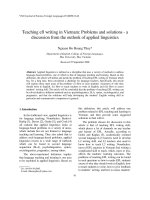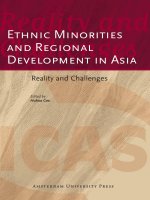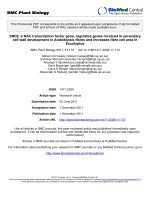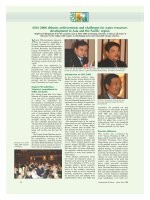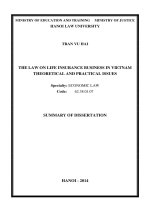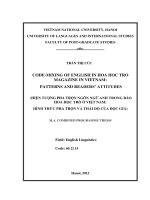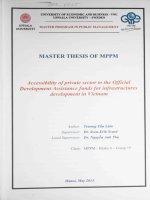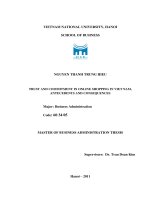DAM DEVELOPMENT IN VIETNAM - ACHIEVEMENTS AND CHALLENGES
Bạn đang xem bản rút gọn của tài liệu. Xem và tải ngay bản đầy đủ của tài liệu tại đây (444.68 KB, 10 trang )
1
DAM DEVELOPMENT IN VIETNAM - ACHIEVEMENTS AND CHALLENGES
Pham Hong Giang
1
,
Pham Hong Nga
2
, Pham Hong Viet Thanh
3
,
ABSTRACT
Vietnam is a South - East Asian country, which is affected by the subtropical humid
moonsoon climate. Its annual rainfall is high and most of its territory (especially in the
North and the Central parts) is mountainous and has good potential for water reserves and
hydropower. Moreover, rainfall, almost the only source of surface flow, concentrates in a
few months yearly during the rainy season. Therefore, there is an urgent need to be
regulated by reservoirs. The Dam Development Strategy has a key role in Vietnam
economic-social programs: power generation; flood disaster mitigation; irrigation, water
supply for life and industry; transport; and environment promotion. A number of large
dams (higher than 50m) are under construction now or in the near future. Dam
development in Vietnam faces chalenges relating to the extreme floods and drought due
to the climate change, the upper river basins outside the territory, the environment
impacts, the land inundation and resettlement...
1. Natural Characteristics and Major River Basins
Location:Vietnam is situated in South - East Asia with its main land lying between north
parallels 8
0
- 23
0
and east meridians 102
0
- 109
0
. It has a territory of 331,000 km
2
and a
population of 83 mil. . The country’s mountainous topography (three-quarters are
mountains and hills) and subtropical humid monsoon climate profoundly affect the
quantity and distribution, both temporally and spatially, of water.
Water Resources Redistribution: Mean annual rainfall, which almost is the only source of
surface flow, is about 2,000 mm; but about 75% acumulates in only three months (more
than 30% usually in only one peak month). This occurs from July to September in the
Northern and Southern areas and from September to December in the Central area.
1
Professor, Former Vice-Minister, Chairman of Vietnam National Committee on Large Dams; 95/12G
Chua Boc Str., khu DH Thuy Loi, Dong Da, Hanoi, Vietnam.
2
MSc., Water Resources University; Tay Son Str., Dong Da, Hanoi, Vietnam.
3
MSc., Vietnam Water Resources Academyr., Tay Son Str., Dong Da, Hanoi, Vietnam
2
Figure 1. Location of dams
mentioned in the text
Cua Dat CFR Dam
H119m , V1.45bil.m
3
Hoa Binh CCR Dam, H128m
V9.5bil.m
3
, P1920MW
Ialy CCRDam,H69m
V928mil.m
3
,P720MW
Easoup Earth Dam
H27m,V149mil.m
3
Dau Tieng Earth
Dam,H28m,
V1.6bil.m
3
Phuoc Hoa Weir, H28m
Dinh Binh RCC
Dam , H53m
V226mil.m
3
Ban Ve RCC dam
H1379m, V1.8bil.m
3
P400MW
Son La RCC Dam
H138m, V12.5bil.m
3
P2400MW
Tri An CCR Dam
H40m , V2.7bil.m
3
P400MW
Ca Giay
Earth Dam
H26m
V36mil.m
3
Phu Ninh
Earth Dam
H40m
V344mil.m
3
Trang Vinh Earth Dam
H28m , V75mil.m
3
3
The mean annual runoff totals 880 billion m
3
(ranking 12
th
in the world), of which 70% is
generated outside the border lines and flows downstream into Vietnam. The
mountainous landscape offers substantial potential for hydropower and water storage. In
wet seasons this promotes rapid flood concentrations, makes heavy inundation in alluvial
plains and deltas, where most big cities are located. In dry seasons, there are water
shortages (the minimum monthly flow of most basins is just 1% of annual runoff) and
drought, which threaten the water supply and living condition of millions people with
impacts on environment, agriculture, aquaculture, etc… General task in the water sector
is flow redistribution to water storage in wet season for flood mitigation then flow
promotion in next dry season by use of both construction (dyke, reservoir,
weir,sluice,canal,…) and non-construction (afforestation, inhabitant relocation ,.. )
measures.
Major River Basins: As for characteristics of topography and river basins, Vietnam is
considered to be composed of three regions: Northern, Central and Southern ones
(fig.1).
Almost half North Vietnam belongs to the Red River System Basin of 87,000 km
2
(the
rest is outside the border) and taking more than 15% of total runoff of the country. The
Red River Delta is of 16,654 km
2
with a high density of population and big cities. Beside
the task of power generation for the whole country, big reservoirs therein must have an
important part in flood mitigation in the delta together with an embankment river dyke
system, which have been built for many centuries and also directly protects the delta from
floods.
Central Vietnam stretches from the North ( parallel 20
o
) to the South ( parallel 11
o
) and is
composed of two subregions: the East Coastland and the South –West Highlands. The
coastal subregion, a very narrow land strip between mountains and sea, is composed of a
lot of small separate basins (the largest of them are less than 30,000 km
2
). They have
considerable hydropower potential due to their high stream slopes as sources of the rivers
are in the mountainous areas close to the coastline. This subregion faces yearly 7÷10
typhoons and tropical storms coming from East Pacific Ocean with high rainfall and
flood peaks. Sources of Mekong tributaries are in the highlands. They flow towards the
main stream outside the Western border. Floods and droughts usually come suddenly
right after each other. This situation can be mitigated by reservoirs only in connection
with power generation.
The South Vietnam can be divided into two subregions. The East subregion is the Dong
Nai River Basin (44,100 km
2
) with a big potential of power energy and water supply.
Rapid downstream industrial and urban development (including Ho Chi Minh City)
urgently raises the issue of water requirements. To the West is the downstream Mekong
Delta of 39,000 km
2
in Vietnam territory only (5% of the whole Mekong basin). It takes a
huge water amount about 500 bil. m
3
(more than 60% of total runoff of the country). This
low and plane delta yearly meets with serious challenges of big floods in the wet season
and drought with salinity intrusion in the dry one. No reservoir but many big water
systems (long canals, sluices, field embankment dykes,…) for flood control, inundation
mitigation, irrigation, fishery, aquaculture and water way are needed.
Overview of Dam and Reservoir Development
4
Vietnam has a historical tradition in making water constructions. Old earth dyke systems
in the Red River Basin have been built since 12
nd
century. First big channels were digged
in the Mekong Delta 300 years ago. Some large irrigation systems composed by weirs,
canals and sluices were built in the 1920s and 1930s. More than 2500 pools (each of them
has storage volume less than 5 mil. m
3
) and 500 reservoirs have been built. Since 1990 in
the downstream Da River in North-West Vietnam (70 km to Hanoi) there has come into
operation the big Hoa Binh Reservoir with its volume V=9.5 bil. m
3
and a rockfill dam of
height H=128m to generate power of capacity P=1920 MW. Now a more enormous
upstream Son La Reservoir is under construction (it is planned to operate the 1
st
turbine
in 2009) with V=12.5 billion m
3
and a roller compacted concrete dam of H=139m to
generate power P=2400 MW.
Reservoirs in Vietnam are of two categories, in which the first ones especially for energy
and the other multipurpose reservoirs for combination of flood mitigation, water supply,
irrigation and power generation. There are presently 3 National Programs with more than
10 bil. USD investment being implemented in 10 years (2005-2015):
• Program for Medium and Small Water Systems in dispersed areas in highlands and
mountains aiming at satisfying local water demand and reducing poverty;
• Program for Large Multipurpose Water Systems with big reservoirs (V=0.3÷1.5
billion m
3
) and high dams (H=50 ÷115m);
• Program for Large Hydro Power Plants with high power capacity (P=150÷2400
MW).
TECHNICAL ASPECTS OF DAMS
In Vietnam the largest earthfill dam is of H=60m; clay core-wall rockfill (CCR) dam
H=128m; concrete face rockfill (CFR) dam H=119m; traditional gravity concrete dam
H=46 m; roller compacted concrete (RCC) dam H=53÷139m (fig.2). Beside common
technical demands, the dam construction therein needs much special technical research
works such as: flood frequency design; optimum combination of local material dam and
Figure 2
.
Type of large dams (materials)
57%
14%
3%
19%
7%
earth dams
Rockfill w ith core
Rockfill+RC face
RCC dams
Concrete
For many years the frequency of extremum flood design has been taken as 0.1% based on
the Statistics Modelling (SM) for large dams (more than H=40m) according to the
Vietnamese State Standard. However numerous factors have affected flooding: global
and regional changes of climate; decline of forests; human socio-economic activities;…
Therefore some recent big floods have seriously threatened dam safety. The flood design
spillway sizes;
river diversion
versus peak flood;
dam material
treatmen;…due to
natural conditions.
Flood Frequency
Design
5
0
2
4
6
8
01234567891011
time
(10 hours)
flood discharge (1000 cub.meters/s)
―
design
―
recent review
―
PMF
Figure 3. Flood process analysis of Phu Ninh Reservoir.
value has been urgently reviewed to promote the safety of existing dams and amended the
Standard for forthcoming dams. The Probable Maximum Precipitation (PMP) procedure
has been discussed and applied for the Probable Maximum Flood (PMF) value.
For example, flood design value of Phu Ninh Dam has been reviewed. This earthfill dam
of H=40 m was built in 1982 on the Tam Ky River in Quang Nam Province with its
basin 235 km
2
to make a reservoir of V=344 mil. m
3
. The dam was designed in 1976.
Since then data have been added to the annual flood and rainfall series. The statistical
analysis of the added series shows considerable difference compared with the design
values of 30 years ago. Flood putting the dam in much danger in 1999 is only of 1.8%
frequency. The PMF analysis has been carried out and numerical results are showed as
follows (fig.3):
Frequency
(%)
Flood Discharge
(m
3
/s)
Total Runoff in
72 hours (10
6
m
3
)
SM
Designed in 1976
0.1
5270 364.0
Recently reviewed 6180 457.1
Big Flood in 1999 1.8 2887 303.2
PMF 6979 948.8
It is seen that SM could only give more exact results when the series is sufficiently long.
In the case of this dam, the SM design flood discharge and total runoff (in 72 hours)
values are 17% and 25% forcer after updating the series. The PMF value shows itself to
be much safe for design. It is proposed that the SM be applied for design and the PMF for
utmost safety. Much more research and investigation, including flood morphology
analysis, will have to continue for a satisfactory conclusion.
Optimum Combination of Local Material Dam and Spillway Sizes
Local material (LM: earthfill, rockfill with clay core,…) dams, which would be damaged
by overflow, are in flood safety in combination with spillway capacity. Formely such a

